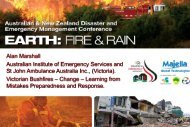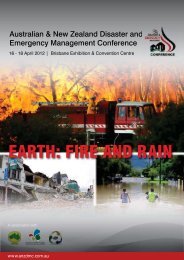Book of Abstracts 2013 - Australian and New Zealand Disaster ...
Book of Abstracts 2013 - Australian and New Zealand Disaster ...
Book of Abstracts 2013 - Australian and New Zealand Disaster ...
Create successful ePaper yourself
Turn your PDF publications into a flip-book with our unique Google optimized e-Paper software.
managers from around the world challenged to come up with a recovery plan for several disaster scenarios. Inspired by<br />
the floods <strong>of</strong> 2011, this IPMA Young Crew workshop was held for the first time in the southern hemisphere, in Brisbane,<br />
10 months after disaster hit that city (<strong>and</strong> state). The teams, created on the day, were each given a disaster that had<br />
occurred globally in the previous 12 months <strong>and</strong> tasked with developing a crisis management plan for that scenario<br />
using project management principles. The obstacles included language barriers, cultural differences, alternative<br />
training context <strong>and</strong> content, time factors <strong>and</strong> changing requirements. The “real-life” situation <strong>of</strong> disaster management<br />
was duplicated as much as possible to allow the teams to get a true sense <strong>of</strong> what it may be like to be involved in<br />
recovery <strong>and</strong> management plans. The presentation <strong>of</strong>fers insight into the techniques used <strong>and</strong> the benefits realised<br />
from the 2 day workshop.<br />
Dr Mahesh Prakash<br />
Principal Research Scientist, CSIRO<br />
Co Author - Mr Stuart Mead, Graduate Fellow, CSIRO. Dr James Hilton, Research Scientist, CSIRO.<br />
Coastal Inundation: Simulation <strong>and</strong> visualisation strategies for better community<br />
engagement <strong>and</strong> risk assessment<br />
Estimating coastal inundation due to extreme weather conditions such as storm surges <strong>and</strong> cyclones, a tsunami event<br />
or due to sea level rise caused by climate change have become an important topic <strong>of</strong> consideration for managing<br />
existing structures as well as for planning purposes to build new coastal infrastructure. Flow modelling including<br />
computational fluid dynamic simulations is now used regularly to determine inundation levels, arrival times <strong>and</strong> flood<br />
maps for various coastal inundation problems. However current techniques are not able to provide a clear visual<br />
account <strong>of</strong> such events due to limitations including inability to capture the large scale flow in three dimensions <strong>and</strong><br />
poor visualisation caused by lack <strong>of</strong> integration <strong>of</strong> the flow modelling with state <strong>of</strong> the art 3D visualisation methods.<br />
Using case studies this paper presents the value <strong>of</strong> integrating 3D flow modelling techniques with the latest<br />
visualisation methods for coastal inundation. The ability <strong>of</strong> this integrated approach in assisting authorities for better<br />
informed planning, mitigation <strong>and</strong> management will be discussed.<br />
Miss Carol Readshaw<br />
Senior Policy Officer, <strong>Disaster</strong> Preparedness & Management Unit, WA Health<br />
AllocateME – A Smartphone application to track <strong>and</strong> communicate casualty details in a mass<br />
casualty incident<br />
The accurate allocation <strong>of</strong> casualties to definitive care in a mass casualty incident ensures better outcomes for patients<br />
as well as reducing the burden on resources. Real time information is critical to determine appropriate patient<br />
allocation to health care facilities, based on injury type <strong>and</strong> the capability <strong>of</strong> the receiving facility (Killeen, Chan, Buono,<br />
Griswold & Lenert, 2006). To correctly allocate casualties decision makers need clear, accurate <strong>and</strong> timely access to<br />
information. Traditionally radio communications have been heavily relied upon to transmit information. Details<br />
received can be difficult to hear <strong>and</strong> may not be presented in a logical, sequential or timely manner. To address this<br />
issue I have created ‘AllocateME’, an application that utilises Smartphone technology to communicate casualty details<br />
from a disaster site to a central location in real time. With AllocateME casualty details are sent to a central database.<br />
Key information communicated includes priority, triage tag number, gender, age group, primary <strong>and</strong> secondary injury,<br />
name, a photo to assist in reunification, intubation status <strong>and</strong> a recommended care setting. Decision makers can view<br />
information in real time <strong>and</strong> are able to make informed hospital allocation decisions which can be relayed to the<br />
transport nurse at the disaster scene. The application can also capture transport details such as departure time <strong>and</strong><br />
mode <strong>of</strong> transport. Tracking <strong>of</strong> patient from the incident scene to definitive care is made possible by linking the unique






